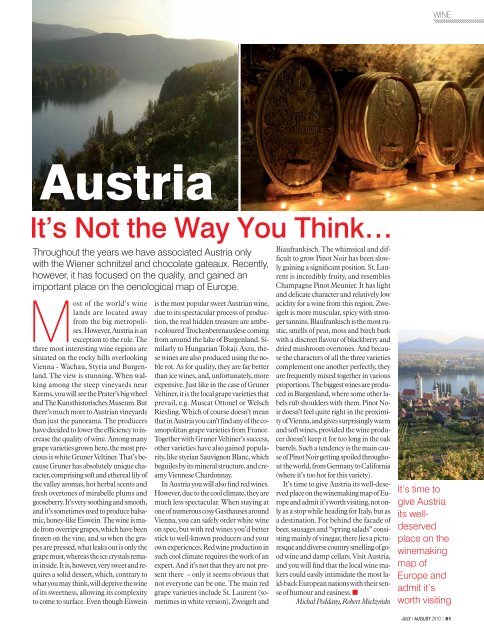BUDAPEST - Business Traveller
BUDAPEST - Business Traveller
BUDAPEST - Business Traveller
You also want an ePaper? Increase the reach of your titles
YUMPU automatically turns print PDFs into web optimized ePapers that Google loves.
Austria<br />
It’s Not the Way You Think…<br />
Throughout the years we have associated Austria only<br />
with the Wiener schnitzel and chocolate gateaux. Recently,<br />
however, it has focused on the quality, and gained an<br />
important place on the oenological map of Europe.<br />
of the world’s wine<br />
lands are located away<br />
from the big metropolises.<br />
However, Austria is an<br />
�Most<br />
exception to the rule. The<br />
three most interesting wine regions are<br />
situated on the rocky hills overlooking<br />
Vienna - Wachau, Styria and Burgenland.<br />
The view is stunning. When walking<br />
among the steep vineyards near<br />
Krems, you will see the Prater’s big wheel<br />
and The Kunsthistorisches Museum. But<br />
there’s much more to Austrian vineyards<br />
than just the panorama. The producers<br />
have decided to lower the effi ciency to increase<br />
the quality of wine. Among many<br />
grape varieties grown here, the most precious<br />
is white Gruner Veltiner. That’s because<br />
Gruner has absolutely unique character,<br />
comprising soft and ethereal lily of<br />
the valley aromas, hot herbal scents and<br />
fresh overtones of mirabelle plums and<br />
gooseberry. It’s very soothing and smooth,<br />
and it’s sometimes used to produce balsamic,<br />
honey-like Eiswein. The wine is made<br />
from overripe grapes, which have been<br />
frozen on the vine, and so when the grapes<br />
are pressed, what leaks out is only the<br />
grape must, whereas the ice crystals remain<br />
inside. It is, however, very sweet and requires<br />
a solid dessert, which, contrary to<br />
what you may think, will deprive the wine<br />
of its sweetness, allowing its complexity<br />
to come to surface. Even though Eiswein<br />
is the most popular sweet Austrian wine,<br />
due to its spectacular process of production,<br />
the real hidden treasure are amber-coloured<br />
Trockenberenauslese coming<br />
from around the lake of Burgenland. Similarly<br />
to Hungarian Tokaji Aszu, these<br />
wines are also produced using the noble<br />
rot. As for quality, they are far better<br />
than ice wines, and, unfortunately, more<br />
expensive. Just like in the case of Gruner<br />
Veltiner, it is the local grape varieties that<br />
prevail, e.g. Muscat Ottonel or Welsch<br />
Riesling. Which of course doesn’t mean<br />
that in Austria you can’t fi nd any of the cosmopolitan<br />
grape varieties from France.<br />
Together with Gruner Veltiner’s success,<br />
other varieties have also gained popularity,<br />
like styrian Sauvignon Blanc, which<br />
beguiles by its mineral structure, and creamy<br />
Viennese Chardonnay.<br />
In Austria you will also fi nd red wines.<br />
However, due to the cool climate, they are<br />
much less spectacular. When staying at<br />
one of numerous cosy Gasthauses around<br />
Vienna, you can safely order white wine<br />
on spec, but with red wines you’d better<br />
stick to well-known producers and your<br />
own experiences. Red wine production in<br />
such cool climate requires the work of an<br />
expert. And it’s not that they are not present<br />
there – only it seems obvious that<br />
not everyone can be one. The main red<br />
grape varieties include St. Laurent (sometimes<br />
in white version), Zweigelt and<br />
Biaufrankisch. The whimsical and diffi<br />
cult to grow Pinot Noir has been slowly<br />
gaining a signifi cant position. St. Laurent<br />
is incredibly fruity, and resembles<br />
Champagne Pinot Meunier. It has light<br />
and delicate character and relatively low<br />
acidity for a wine from this region. Zweigelt<br />
is more muscular, spicy with stronger<br />
tannins. Blaufrankisch is the most rustic,<br />
smells of peat, moss and birch bark<br />
with a discreet fl avour of blackberry and<br />
dried mushroom overtones. And because<br />
the characters of all the three varieties<br />
complement one another perfectly, they<br />
are frequently mixed together in various<br />
proportions. The biggest wines are produced<br />
in Burgenland, where some other labels<br />
rub shoulders with them. Pinot Noir<br />
doesn’t feel quite right in the proximity<br />
of Vienna, and gives surprisingly warm<br />
and soft wines, provided the wine producer<br />
doesn’t keep it for too long in the oak<br />
barrels. Such a tendency is the main cause<br />
of Pinot Noir getting spoiled throughout<br />
the world, from Germany to California<br />
(where it’s too hot for this variety).<br />
It’s time to give Austria its well-deserved<br />
place on the winemaking map of Europe<br />
and admit it’s worth visiting, not only<br />
as a stop while heading for Italy, but as<br />
a destination. For behind the facade of<br />
beer, sausages and “spring salads” consisting<br />
mainly of vinegar, there lies a picturesque<br />
and diverse country smelling of good<br />
wine and damp cellars. Visit Austria,<br />
and you will fi nd that the local wine makers<br />
could easily intimidate the most laid-back<br />
European nations with their sense<br />
of humour and easiness. ■<br />
Michał Poddany, Robert Miełżyński<br />
WINE<br />
It’s time to<br />
give Austria<br />
its welldeserved<br />
place on the<br />
winemaking<br />
map of<br />
Europe and<br />
admit it’s<br />
worth visiting<br />
JULY / AUGUST 2010 | 61






